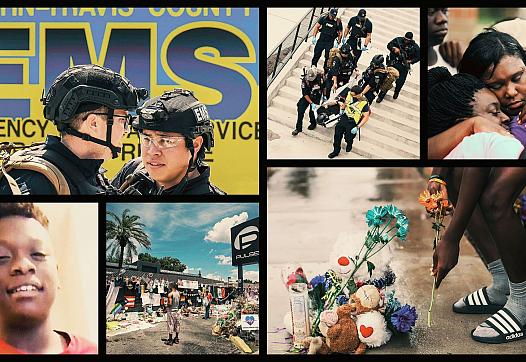A North Texas Man Nearly Died After A Horrific, Head-on Crash. Here's What Saved Him
The story was originally published by The Dallas Morning News with support from our 2022 National Fellowship.

Wayne Elmore stands with his wife, Jolyn, at his home in the tiny farming town of Mertens, near Corsicana. Elmore was in a head-on crash on a two-lane country road near Mertens in 2019. Critically injured, he survived with the help of a blood transfusion as he was flown to a trauma hospital in Dallas.
Smiley N. Pool / Staff Photographer
As soon as the call came in, Virgil Cross knew the situation was urgent.
It was a little after 6 a.m. on Dec. 2, 2019, and Cross was nearing the end of his 24-hour shift as a paramedic in Corsicana, about an hour south of Dallas. After responding to several calls the night before, he and his partner were tired. They had less than an hour to go when the alert came in about a high-speed, head-on collision near Mertens, a tiny farming town about 25 miles to the west.
It would take at least a half-hour to get there, so Cross called for helicopter backup before leaving.
At the scene, he surveyed the damage.
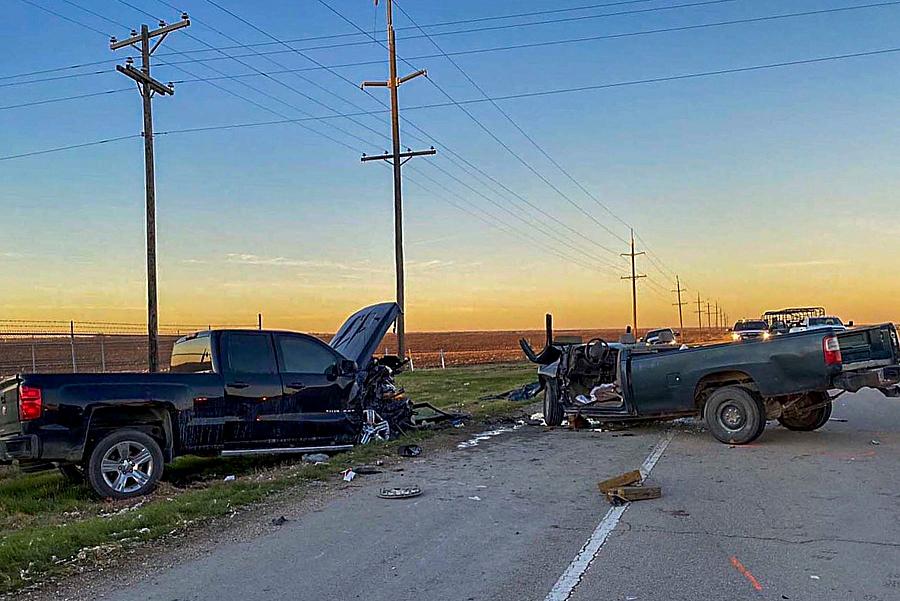
Paramedics at the scene that day provided this photo of the wreckage of the two pickups in the 2019 head-on collision involving Wayne Elmore, who was driving the truck on the right, was on his way to his job as a school bus driver in nearby Frost that early morning.
Smiley N. Pool / Staff Photographer
Along the two-lane country highway lay pieces of two mangled pickups. Volunteer firefighters were trying to extricate a man from the crumpled cab of the smaller, older truck, which took the brunt of the damage.
Inside, Wayne Elmore, 58, stared straight ahead, his hands still on the steering wheel. His bloodied face was expressionless and tinged with gray. More blood dripped down his leg, along the side of the seat and onto the asphalt.
They didn’t have much time, Cross thought.
Traumatic injuries from car crashes, shootings, falls and other accidents are the leading cause of death for children and adults under age 45, killing an American about every 3½ minutes and a Texan every 42 minutes in 2020, according to data from the Centers for Disease Control and Prevention. In 2021, Texas had more deaths from motor vehicle crashes and guns than any other state, federal data shows.
Nationwide, most paramedics lack access to blood, even as an estimated 31,000 injured patients die of potentially preventable bleeding each year.
That day, Wayne was in danger of becoming one of them.
A CATASTROPHIC CRASH
As the helicopter circled the crash scene, Cross and his partner, Jacob Sanchez, got to work.
Wayne was headed to his job as a school bus driver in nearby Frost. As his 1996 Toyota T100 pickup crested a hill, a Chevy Silverado crossed into his lane to pass another vehicle and struck him head-on. The impact crushed Wayne against the dashboard and trapped his legs beneath the pedals.
While Cross helped the volunteer firefighters cut through the roof of the cab, Sanchez readied the ambulance. Cross tried talking to Wayne but got only a few mumbled words in response.
After Wayne was freed, Cross took a closer look. There were broken bones from head to toe.
In the ambulance, Wayne’s heart thrummed in overdrive at more than 200 beats per minute. His blood pressure was so low it didn’t register on the machine and his poor circulation made it difficult for medics to find a vein to start an IV. They eventually managed to administer fluids by drilling holes in the bones of his shin and shoulder.
They soon realized it wasn’t working.

Lightning and dark clouds filled the sky over the Williams Gin and Grain cotton gin on Texas 22 between Mertens and Frost during a storm in June. The spot is where Wayne Elmore, who was on his way to work, was critically injured in a head-on collision in 2019. Even by helicopter, the spot is at least 20 minutes from the nearest Level I trauma hospital in Dallas.
Smiley N. Pool / Staff Photographer
Without replacing at least some of the blood Wayne had lost, Sanchez realized, he wasn’t going to make it. Even by helicopter, they were at least 20 minutes from the nearest Level I trauma center in Dallas.
They needed to do something. Fast.
Luckily, the helicopter crew had something their ambulance didn’t.
Blood.
Without replacing at least some of the blood Wayne had lost, Sanchez realized, he wasn’t going to make it. Even by helicopter, they were at least 20 minutes from the nearest Level I trauma center in Dallas.
They needed to do something. Fast.
Luckily, the helicopter crew had something their ambulance didn’t.
Blood.
The morning of Wayne’s crash, Tony Mason had just started his shift as a flight paramedic for PHI Air Medical, a company that operates air ambulances in Texas and more than a dozen other states. As their helicopter landed near Highway 22, Mason spotted the wreck.
They had to work quickly.
Even with fluids being pushed through two IV lines, Wayne’s blood pressure was dangerously low, his pulse too high. As Mason administered oxygen through a mask, he feared the injuries were too much for Wayne’s body to endure, especially given his age.
The helicopter was stocked with two units each of red blood cells and plasma, which the paramedics started carrying a few years earlier.
Wayne got everything they had.
BROKEN EVERYWHERE
By the time Wayne arrived at Parkland Health, he had no pulse.
As soon as the flight crew rolled Wayne into the trauma bay, doctors and nurses initiated CPR and pumped at least 21 more units of blood products into him. Fara Ajani, one of the trauma nurses on duty, worried Wayne’s body would give out.
One thing was clear. Even with the blood products he received from the paramedics, Wayne had arrived on the verge of death. Without them, he never would have made it to Parkland at all.
Somehow, the hospital staff managed to revive him.
While his organs and blood vessels emerged unscathed, Wayne had suffered fractures throughout his body, to 27 bones in all: His face, nose and jaw. Fourteen ribs. Left forearm and wrist, both ankles, right thigh bone and heel. His sternum, right elbow and both kneecaps — all were shattered. There were so many injuries that Jolyn, his girlfriend, asked the medical team for a list so she could better keep up with his care.
With each break, blood had pooled in the spaces left behind. A person can bleed to death internally into their chest cavity or pelvis.
Wayne was broken everywhere. Over the next six weeks, doctors and nurses at Parkland put him back together.
That first night, Jolyn gazed at the Dallas skyline from his hospital room, praying for God to spare his life. She couldn’t do this again.
Almost exactly 15 years earlier, Jolyn’s husband of 19 months had been hit head-on near Waco on his way home from work. He was ejected from the vehicle and died instantly. The thought of losing another partner in the same way was too much to suffer.
Dr. Caroline Park, an emergency and critical care surgeon who treated Wayne while he was in the ICU, said it’s easy for people to tune out accidents like his — until it happens to them, or to someone they love.
“You see a car crash, somebody dies, it’s literally an everyday event, every-hour event. I hate to say it, but people just become almost numb to it,” she said. “But, you know what, that’s someone’s mom, someone’s child, someone’s sister. That affects people’s lives. That person, the rest of their life and all the things they could have contributed to their world, is gone.”
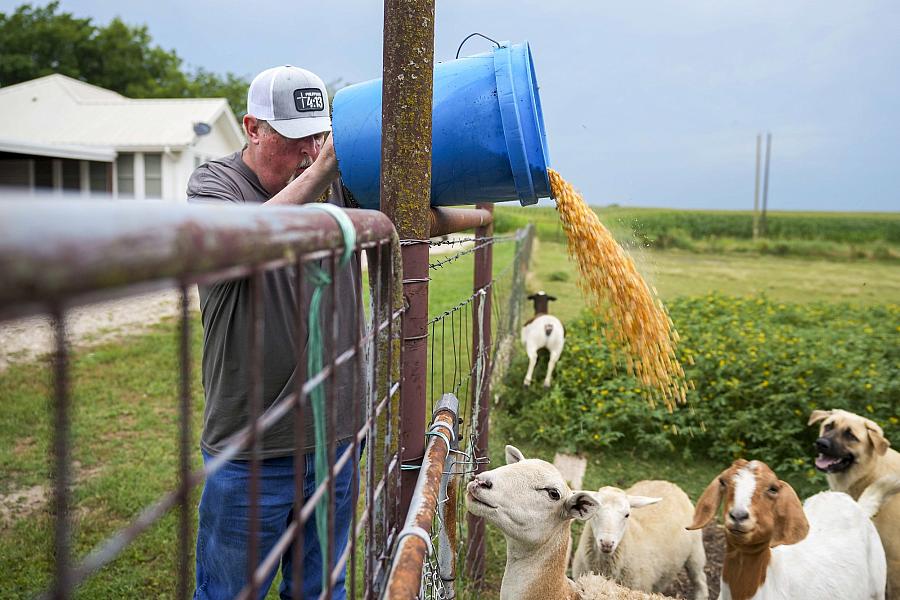
Wayne Elmore fed his sheep and goats in June in Mertens. 'Without blood products, Wayne wouldn't be here today,' said one of the paramedics who helped to save him at the accident on a remote country road in 2019.
Smiley N. Pool / Staff Photographer

The corn fields and windmill seen from their home in Mertens were the inspiration for the cover of Wayne and JoyIn Elmore's book, Inspire... Before you Expire: A true story of Love and Survival. Elmore, now 62, said he often finds himself asking why he survived that terrible accident
Smiley N. Pool / Staff Photographer
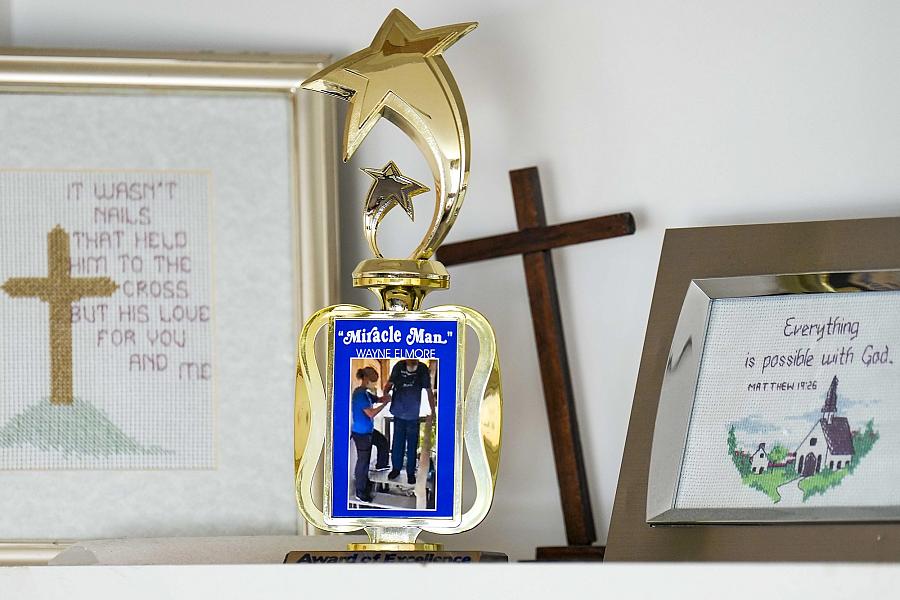
This trophy was presented to Wayne Elmore when he left a rehab center during his recovery from a head-on collision in December 2019 and sits in his home in Mertens. It bears a phot of him learning to walk again and his new moniker, 'Miracle Man.'
Smiley N. Pool / Staff Photographer

Health care workers who treated Wayne Elmore after he suffered massive injuries in a 2019 head-on collision on a remote Hill County road agree that early access to blood saved him.
Smiley N. Pool / Staff Photographer
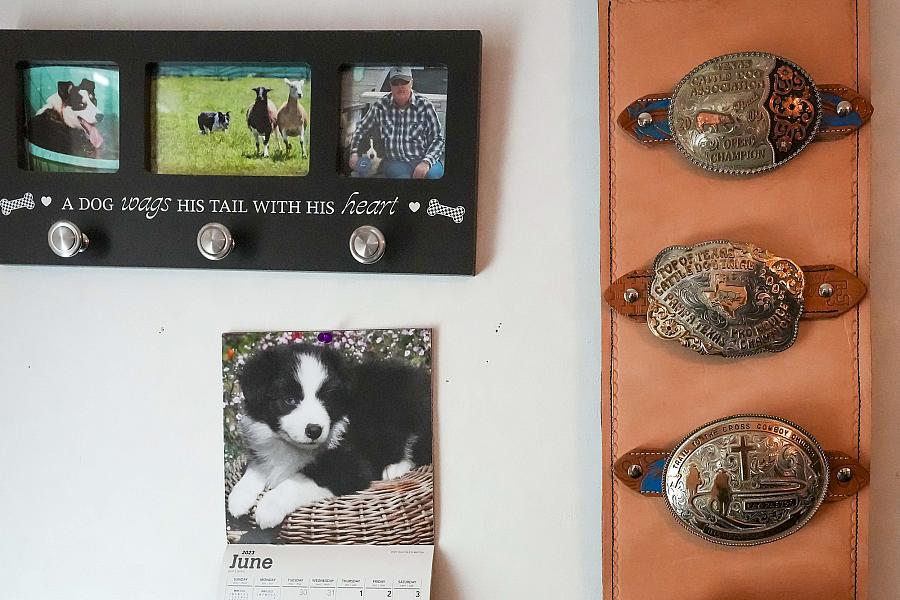
Winners buckles from cattle dog trials and other mementos hand on the walls of the Elmores' home in Mertens. About two years after nearly losing his life, Elmore entered his first stock dog herding contest since the accident. He said he finds dog training more difficult now.
Smiley N. Pool / Staff Photographer

Jolyn Elmore opened a container, bringing one of their cats down from atop the kitchen cabinets, as she and her husband, Wayne, arrived home from church in June. Dr. Caroline Park, an emergency and critical care surgeon who treated Wayne Elmore in the ICU said it's easy for people to tune out accidents like his until it happens to them or to someone they love.
Smiley N. Pool / Staff Photographer

Jolyn Elmore laughed at one of Wayne's jokes as they stopped for a cold drink at a Sonic on their way to Bible study in Hillsboro in May. 'Life is very precious, and we should not take it for granted,' they wrote in their book about the ordeal
Smiley N. Pool / Staff Photographer
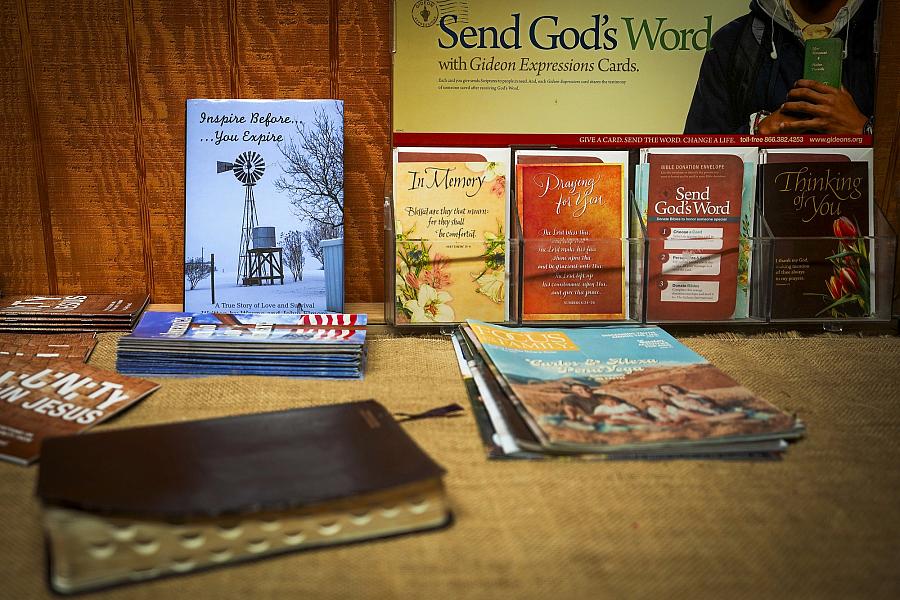
Wayne and Jolyn Elmore's book, Inspire... Before You Expire: A True Story of Love and Survival is set out among prayer cards at their cards at their church in Hillsboro on May 24.
Smiley N. Pool / Staff Photographer

Wayne and Jolyn Elmore bowed their heads in prayer during services at Trail to The Cross Cowboy Church in Hillsboro in June. The Elmore self-published a book about the ordeal and the importance of their faith through it all.
Smiley N. Pool / Staff Photographer
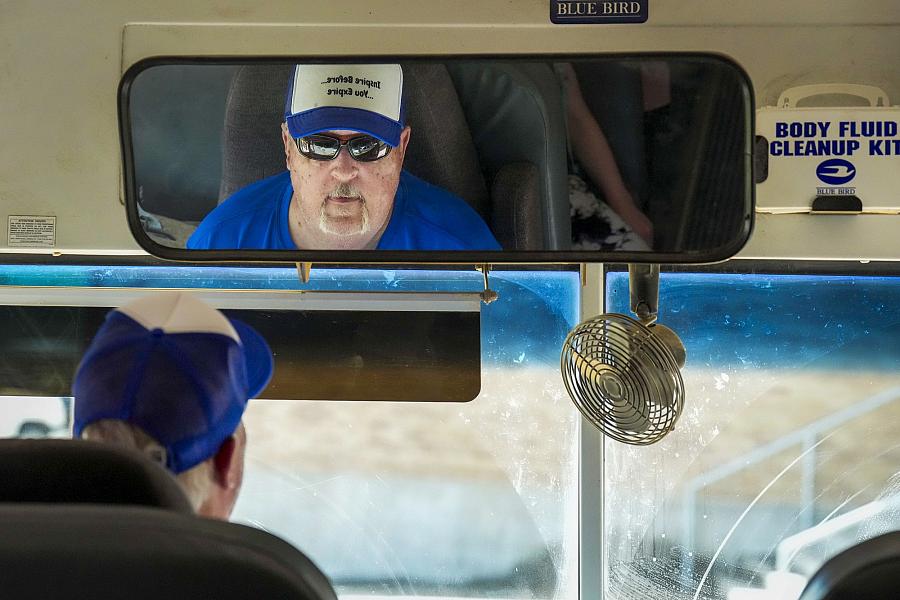
Wayne Elmore got behind the wheel to drive his afternoon Frost independent School District bus route in late May. Almost two years after the crash, Elmore returned to his job as a school bus driver.
Smiley N. Pool / Staff Photographer
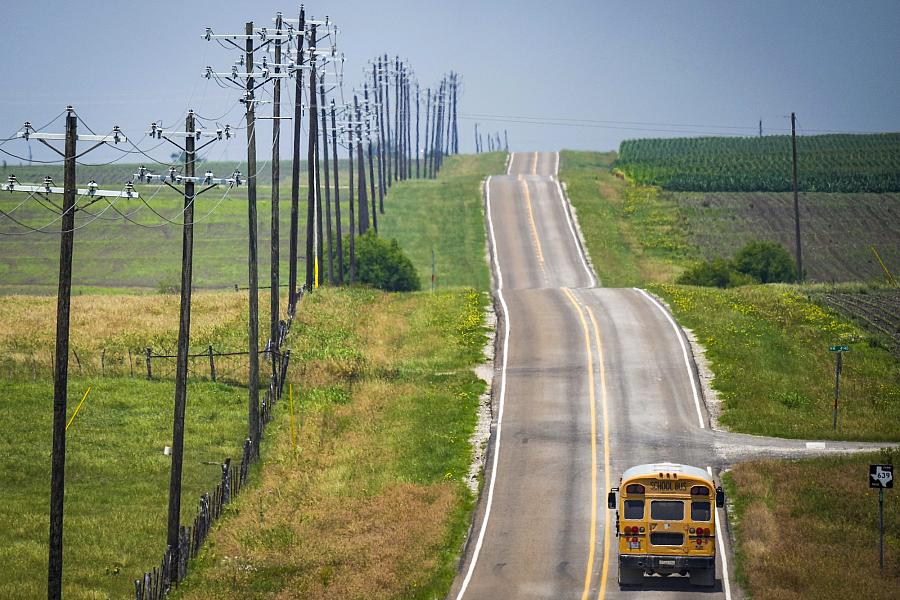
Almost two years after Wayne Elmore was critically injured in a head-on collision on his way to work early one December morning in 2019, he returned to his job driving his school bus route. Twice a day, that route takes him past the spot where the accident happened.
Smiley N. Pool / Staff Photographer

A characteristic joke from Wayne Elmore(center) brought laughter from his wife, Jolyn, and family friend Kend Moody while having lunch after church in June in Hillsboro. Last December, he spoke to parkland medical residents about his experience as a trauma patient.
Smiley N. Pool / Staff Photographer
Park and the other health care workers who treated Wayne agree early access to blood saved his life.
“Without blood products, Wayne wouldn’t be here today,” said Cross, the Corsicana paramedic.
While he was bedridden, Wayne reflected on how lucky he was. He had been given more time with those he loved. In Facebook posts, he took to signing off with the moniker Miracle Man, a reminder of God’s many gifts.
As Christmas approached, he was still in the ICU, so members of his church visited to sing “O Holy Night.”
The first day he was able to breathe on his own, he asked Jolyn to marry him. Three months later, in April 2020, they wed in a small ceremony at their church in Hillsboro.
Wayne is back to cracking silly jokes and attending weekly services with Jolyn. In January 2021, he entered his first stock dog herding contest since the accident, but the training is more difficult now. Almost two years after the crash, he returned to his job as a school bus driver. Twice a day, his route takes him past the spot where the accident happened.
He still regularly visits with the medical workers who saved his life. Last December, he spoke to Parkland medical residents about his experience as a trauma patient. Earlier this year, he visited the nursing home where he recuperated and the flight paramedics who saved his life.
Now 62, Wayne finds himself asking why he survived. By all accounts, he shouldn’t be here. Maybe God still had work for him to do. Maybe that was sharing his story.
In 2022, Wayne and Jolyn self-published a short book, Inspire … Before You Expire: A True Story of Love and Survival. Many people in their community bought the book, which discusses how the ordeal reinforced the importance of their faith. Sometimes, the couple wears matching T-shirts with the same picture — of a windmill near their home — that’s on the book’s cover.
“Life is very precious, and we should not take it for granted,” they wrote in the afterword. “You never know when you may be taken from this world. We are not promised our next breath.”

Wayne and Jolyn Elmore held hands as they arrived at the PHI helicopter base in Corsicana to visit members of the crew that saved his life. The first day Elmore was able to breathe on his own, he asked Jolyn to marry him. They wed three months later.
Smiley N. Pool / Staff Photographer


